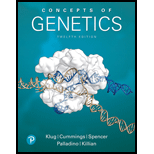
Concept explainers
Although histone modifications can activate or silence genes, these covalent alterations are made to protein molecules involved in nucleosome structure and not to the DNA carrying the activated or silenced allele. If the fixed pattern of active and silenced alleles is to be carried through multiple cell divisions, would you expect the histone modifications to be in cis or trans to the affected alleles? Why?
Hint: This problem involves an understanding of how many copies of each histone are contained in a nucleosome and of the spatial relationship between the histones and the DNA wound around the nucleosome.
To determine: The presence of cis or trans histone modifications in the affected alleles in several cell divisions.
Introduction: The mutation is the change in the nucleotide sequence of the gene, which result in either the formation of a defective protein or no protein at all. The mutation can also alter the regulation of certain genes leading to their hyperactivity or hypoactivity.
Explanation of Solution
The activation of the gene can only take place when the chromatin that contains the gene and its respective regulatory regions to be present in the “open state.” Similarly, for the silencing of the gene, the chromatin containing the gene and its regulatory regions need to be present in a closed state. When these chromatin structures undergo and persist through several cell divisions, the histones that are present in the immediate proximity of the gene, that is cis state will be carrying the histone modifications.
The gene in the chromatin will have to be in a cis state to carry the histone modifications under multiple cell divisions.
Want to see more full solutions like this?
Chapter 19 Solutions
Concepts of Genetics (12th Edition)
- Noggin mutation: The mouse, one of the phenotypic consequences of Noggin mutationis mispatterning of the spinal cord, in the posterior region of the mouse embryo, suchthat in the hindlimb region the more ventral fates are lost, and the dorsal Pax3 domain isexpanded. (this experiment is not in the lectures).a. Hypothesis for why: What would be your hypothesis for why the ventral fatesare lost and dorsal fates expanded? Include in your answer the words notochord,BMP, SHH and either (or both of) surface ectoderm or lateral plate mesodermarrow_forwardNot part of a graded assignment, from a past midtermarrow_forwardNot part of a graded assignment, from a past midtermarrow_forward
- please helparrow_forwardWhat does the heavy dark line along collecting duct tell us about water reabsorption in this individual at this time? What does the heavy dark line along collecting duct tell us about ADH secretion in this individual at this time?arrow_forwardBiology grade 10 study guidearrow_forward
 Biology Today and Tomorrow without Physiology (Mi...BiologyISBN:9781305117396Author:Cecie Starr, Christine Evers, Lisa StarrPublisher:Cengage Learning
Biology Today and Tomorrow without Physiology (Mi...BiologyISBN:9781305117396Author:Cecie Starr, Christine Evers, Lisa StarrPublisher:Cengage Learning Human Heredity: Principles and Issues (MindTap Co...BiologyISBN:9781305251052Author:Michael CummingsPublisher:Cengage Learning
Human Heredity: Principles and Issues (MindTap Co...BiologyISBN:9781305251052Author:Michael CummingsPublisher:Cengage Learning Biology: The Dynamic Science (MindTap Course List)BiologyISBN:9781305389892Author:Peter J. Russell, Paul E. Hertz, Beverly McMillanPublisher:Cengage Learning
Biology: The Dynamic Science (MindTap Course List)BiologyISBN:9781305389892Author:Peter J. Russell, Paul E. Hertz, Beverly McMillanPublisher:Cengage Learning Biology (MindTap Course List)BiologyISBN:9781337392938Author:Eldra Solomon, Charles Martin, Diana W. Martin, Linda R. BergPublisher:Cengage Learning
Biology (MindTap Course List)BiologyISBN:9781337392938Author:Eldra Solomon, Charles Martin, Diana W. Martin, Linda R. BergPublisher:Cengage Learning Biology 2eBiologyISBN:9781947172517Author:Matthew Douglas, Jung Choi, Mary Ann ClarkPublisher:OpenStax
Biology 2eBiologyISBN:9781947172517Author:Matthew Douglas, Jung Choi, Mary Ann ClarkPublisher:OpenStax





